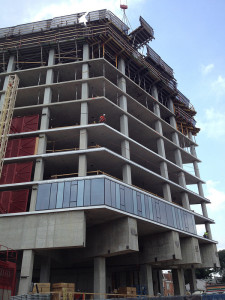Good design is essential for efficient construction, and Madison Concrete has capabilities that include engineering consulting and support to collaborate with our engineering partners.

The American Concrete Institute (ACI) defines high-strength concrete as concrete with a compressive strength greater than 6,000 pounds per square inch (psi). High-strength concrete was used in this Lancaster Square project in the Philadelphia area.
We don’t replace the fine structural and civil engineering firms with whom we partner, but instead, we make sure our team provides the right information related to the intricate details of each concrete construction project we estimate and work on so the owner is guaranteed the best outcome.
Rick Stone, Madison Concrete’s in-house engineer, serves as our expert for owners, designers and construction managers related to all things concrete as well as answer frequently asked questions. Here he address what can be expected from high-strength concrete.
Q: What can you expect from high-strength concrete?
A: The American Concrete Institute (ACI) defines high-strength concrete as concrete with a compressive strength greater than 6,000 pounds per square inch (psi).
Three decades ago, concrete strengths greater than 6,000 psi were considered to be exotic, but today they are commonplace. With improved cements, admixtures, and technology in proportioning, batch control, and quality, the result is consistent quality concrete strengths higher than 12,000 psi.
In the last 20 years, several projects have been constructed in the Philadelphia market using high strength concrete. These projects were mandated by the need for axial high strength in relatively small sized columns, stiffness in shearwall buildings, or a combination of stiffness and strength in foundations. At Madison, we have expanded our portfolio of buildings using high strength concrete and learned how to proportion, mix, transport and place this material to obtain the best results. We have also developed expertise about finishing techniques, as all the high-strength mixes are tricky to finish successfully.
Have you worked on a project with high-strength concrete? We would love to hear about it. We would also love to hear from you about your structural engineering challenges and successes and any questions you might have. Submit your questions to Rick Stone at rstone@madisonconcrete.com.